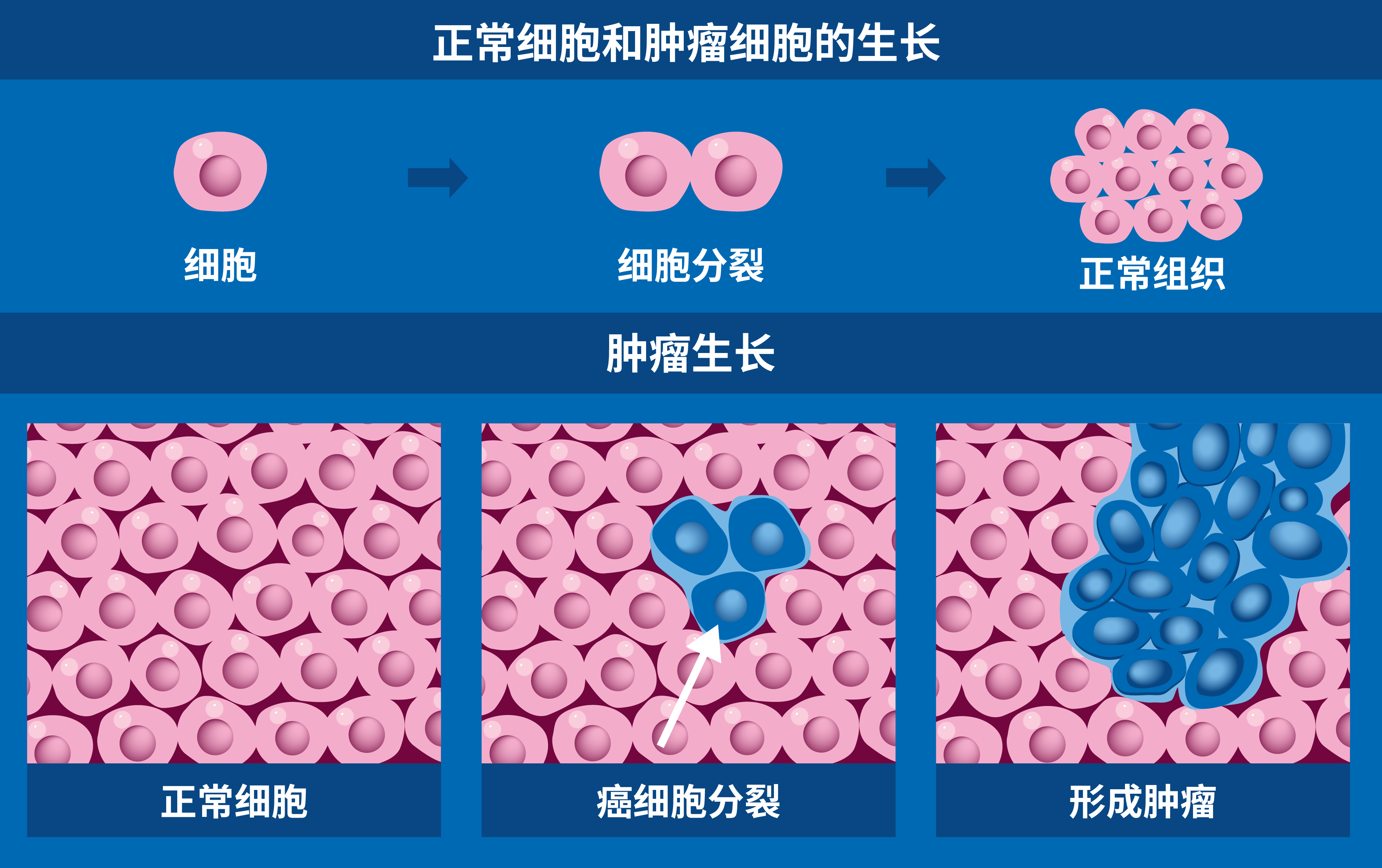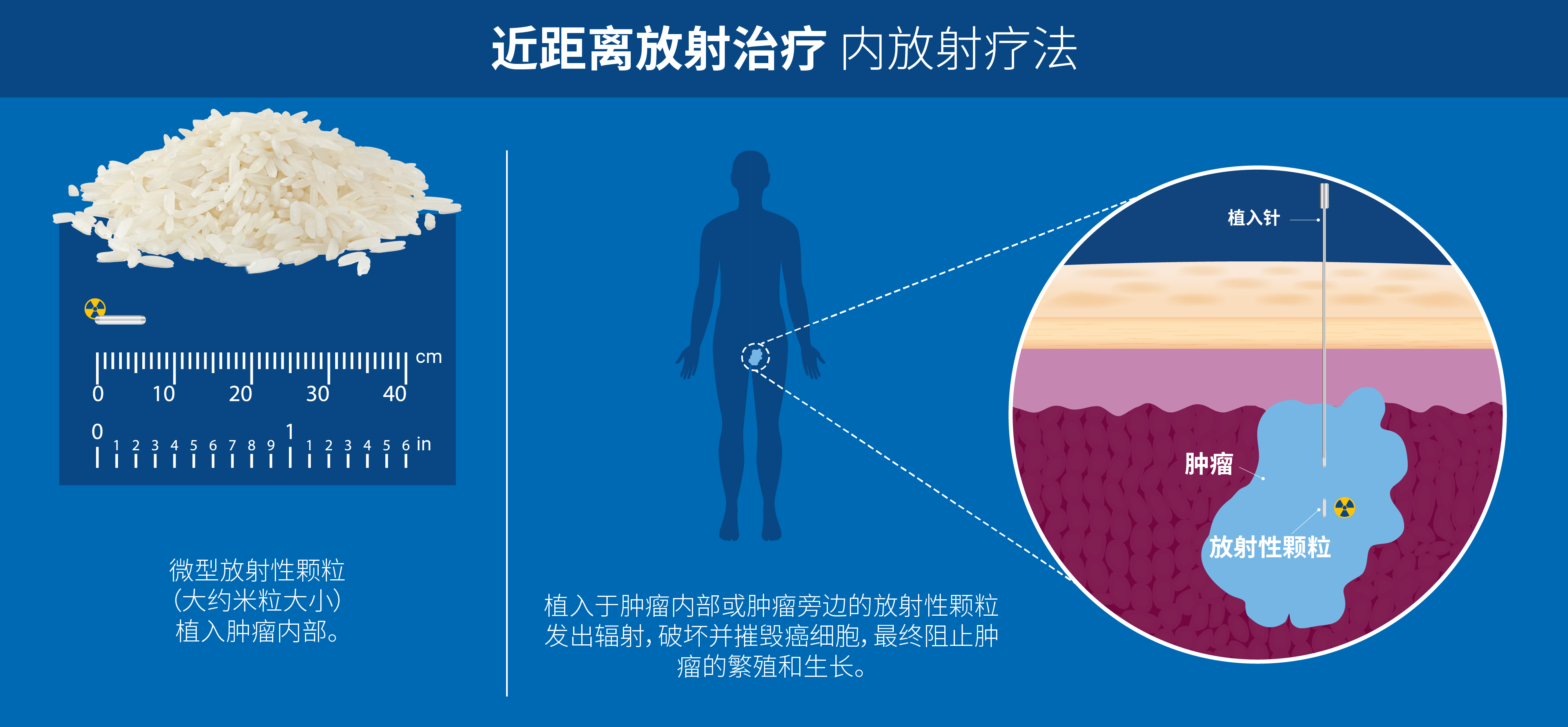辐射疗法,或称放射治疗,是一种癌症治疗方法。治疗中,专家对体内癌细胞进行电离辐射(如X射线、γ射线、高能电子或重粒子)照射,从而杀死癌细胞。放射治疗是最广泛使用的癌症治疗方法之一,大约有一半的癌症患者在病程的某个阶段都需要接受放射治疗。
什么是放射治疗?
辐射疗法,或称放射治疗,是一种癌症治疗方法。治疗中,专家对体内癌细胞进行电离辐射(如X射线、γ射线、高能电子或重粒子)照射,从而杀死癌细胞。
放射治疗如何对抗癌症?
癌症是指身体某个部位的细胞开始不受控制地生长和繁殖,形成肿瘤,影响周围的组织和器官,有时通过血液或淋巴系统扩散到身体的其他部位。
医学成像在放射治疗中有什么作用?
医学成像在癌症患者管理方面发挥着至关重要的作用,是计划、实施和评价放射治疗的必要条件。先进成像技术应用于放射治疗,带来了癌症护理的革命,患者疗效得到改进。就此而言,医学成像的作用包括:
评估癌症的位置和扩散情况
医学成像可用于确定癌症是处于早期阶段还是已经扩散到身体的其他部位。图像引导程序(如活检)属于微创手术,是进行准确的组织诊断所必需的。
医学成像技术(如计算机断层照相法、超声、磁共振成像和正电子发射断层照相法)对于癌症的准确诊断和分期至关重要。这些技术有助于确定肿瘤的位置、大小和范围、肿瘤与周围结构的关系以及肿瘤是否转移。
治疗规划
医学成像可用于治疗规划:从药物治疗和放射治疗到手术或者在某些情况下的姑息治疗。在放射治疗规划时,医学成像能生成肿瘤的三维图像,使放射治疗对肿瘤的靶向性更好,同时尽量减少对健康组织的伤害。
图像引导放射治疗是在放射治疗过程中纳入了实时医学成像,以确保辐射剂量准确且均匀。
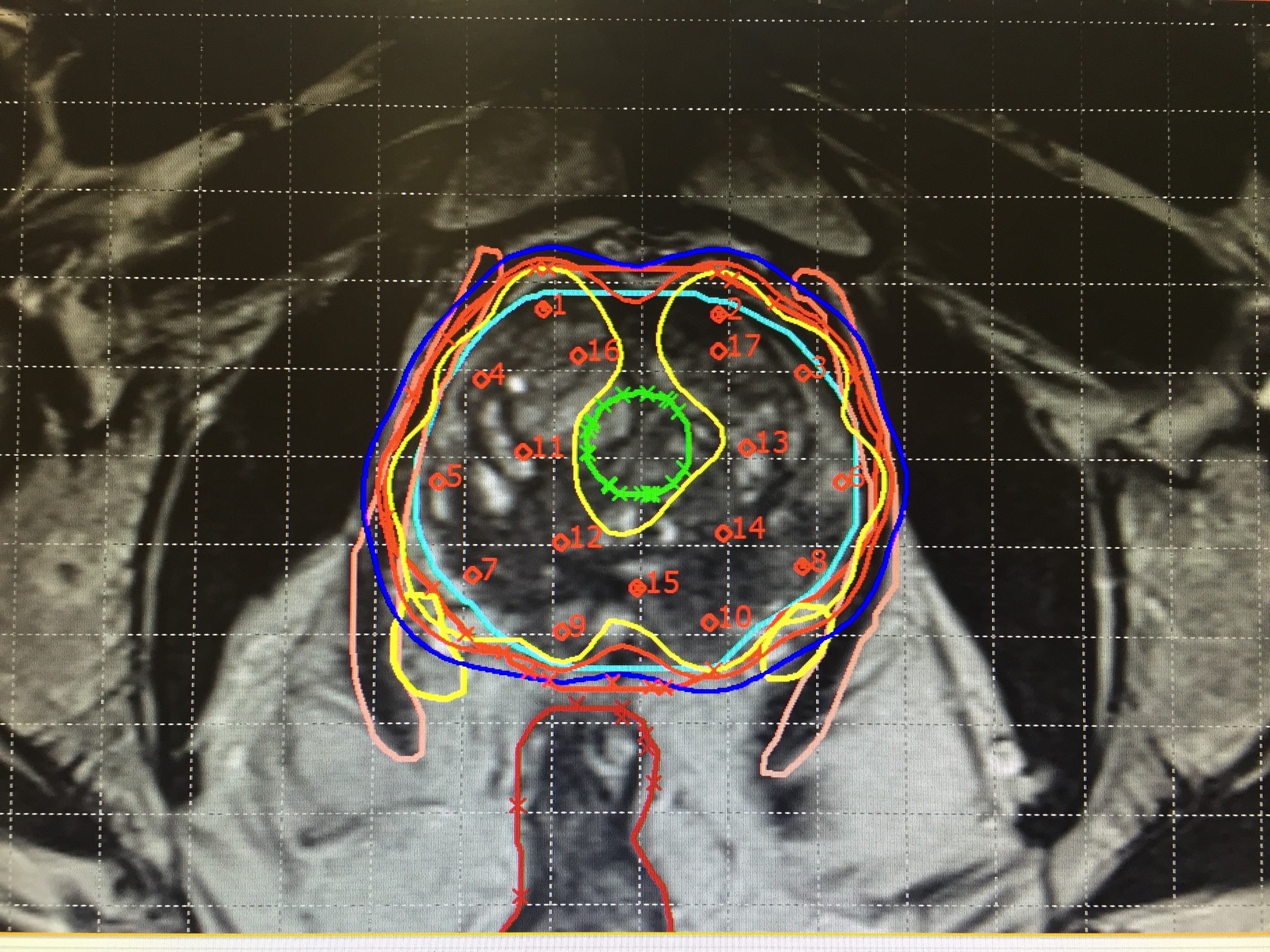
详尽的医学图像有助于医疗卫生专业人员区分肿瘤、健康组织和器官,以确保准确地以癌细胞为靶向。(照片来源:Auna Oncosalud)
原子能机构的作用是什么?
- 2022年,原子能机构发起了“希望之光”倡议,旨在支持建立和扩大对癌症患者的放射治疗和医学成像服务。该倡议的目的是在最需要的地区建设放射医学方面的能力,同时支持向目前几乎没有或者完全没有机会获得放射治疗的国家提供培训、指导、技术和质量控制。此外,“希望之光”倡议支持开发“支撑中心”,即旨在加强某地区的教育、研究、培训、质量保证和基础设施的地区中心。
- 原子能机构通过其“治疗癌症行动计划”及其与世卫组织和其他全球伙伴的合作,支持各国加强其国家癌症护理服务,促进科学知识的转让,组织教育和培训活动并提供尖端设备。原子能机构提供的援助已帮助许多国家建立和加强辐射医学能力,包括放射治疗、放射学和核医学。
- 自2004年以来,原子能机构实施了“治疗癌症行动计划”综合评定工作组评审 — 一种支持各国改善全面癌症防治的独特评定工具。“治疗癌症行动计划”综合评定工作组评审旨在评定一个国家的癌症护理能力和需求,以确定有效应对其癌症负担所需的优先干预措施。
- 原子能机构发布关于辐射剂量学的国际统一导则和最佳实践建议,帮助各国安全有效地利用辐射医学。原子能机构还通过其安全标准提供指导,协助各国制订适当的职业辐射规范。
- 原子能机构制定了人体健康计划,以支持成员国利用核技术预防、诊断和治疗癌症。该计划提供辐射肿瘤学方面的技术专门知识,并促进和协调临床辐射肿瘤学和应用辐射生物学方面的研究。
- 原子能机构维持着一个剂量学实验室,在建立和传播有关安全有效地利用辐射来诊断和治疗癌症的最佳实践方面发挥着关键作用。该实验室提供有关医用物理学和剂量学的重要质量保证服务,包括用于剂量学测量的参考标准的校准服务和剂量学审核服务。
- 原子能机构搭建了患者辐射防护平台——为医疗卫生专业人员、患者和公众提供的有关在医学中安全有效利用辐射的主要资源。
- 原子能机构拥有“放射治疗中心名录”数据库。该数据库是最全面的放射治疗资源数据库,包括有关放射治疗中心、远距离放射治疗机、近距治疗装置、治疗规划系统、计算机断层照相法系统和模拟器的信息。
How does radiation therapy work against cancer?
Cancer is a condition in which cells in a specific part of the body begin to grow and reproduce uncontrollably, forming tumours which affect surrounding tissues and organs and sometimes spread to other parts of the body through the bloodstream or lymphatic system.
Radiotherapy involves using carefully selected doses of ionizing radiation to damage the DNA of cancer cells. The DNA controls how they divide. Radiation causes the tumour to shrink and, in some cases, die. Radiation therapy has been used since the 1890s to treat almost all types of cancer. It is applied alone or in combination with other treatments, such as chemotherapy or surgery, to cure cancers or control symptoms of the disease.
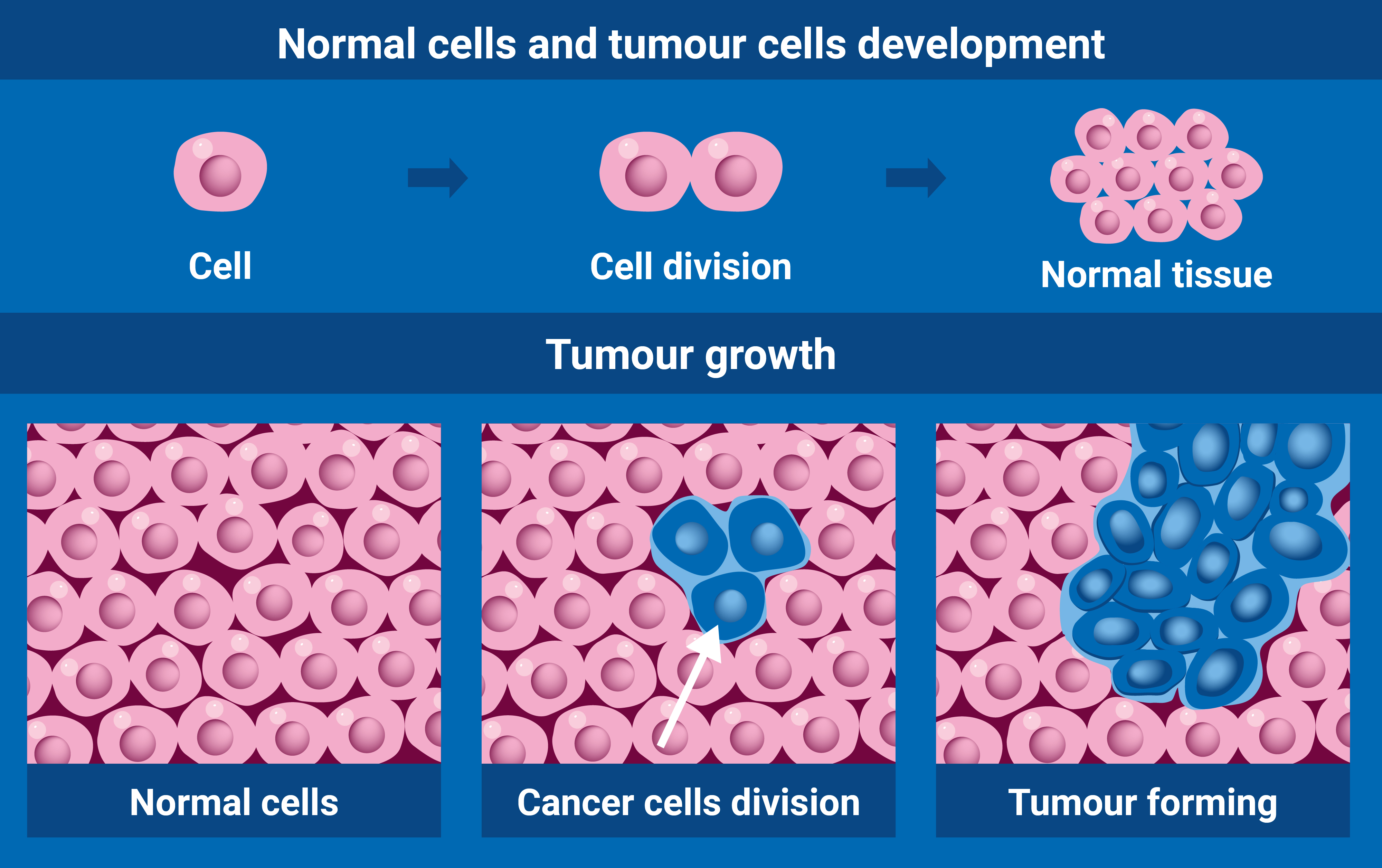
(Graphic: A. Vargas/IAEA)
Types of radiation therapy
Depending on the type and location of cancer, radiation oncologists use two types of radiation therapy, alone or in combination: external, also known as teletherapy, and internal, or brachytherapy.
The selected treatment needs a team of qualified experts, consisting of a radiation oncologist, medical physicist and radiation therapy technologist, who use radiation to destroy the tumour while minimizing harm to healthy cells.
Teletherapy
The most common type of radiation therapy is teletherapy, whereby radiation is delivered to the tumour area in the form of a high-energy beam. This radiation is emitted from a machine located at a distance from the body, such as a cobalt unit or a linear accelerator.
During the therapy, the patient lies motionless on a table while the machine moves around the body, directing precise doses of radiation at the tumour from several angles. The beam size and shape are carefully adjusted to deliver the dose to the tumour while sparing the normal tissues.
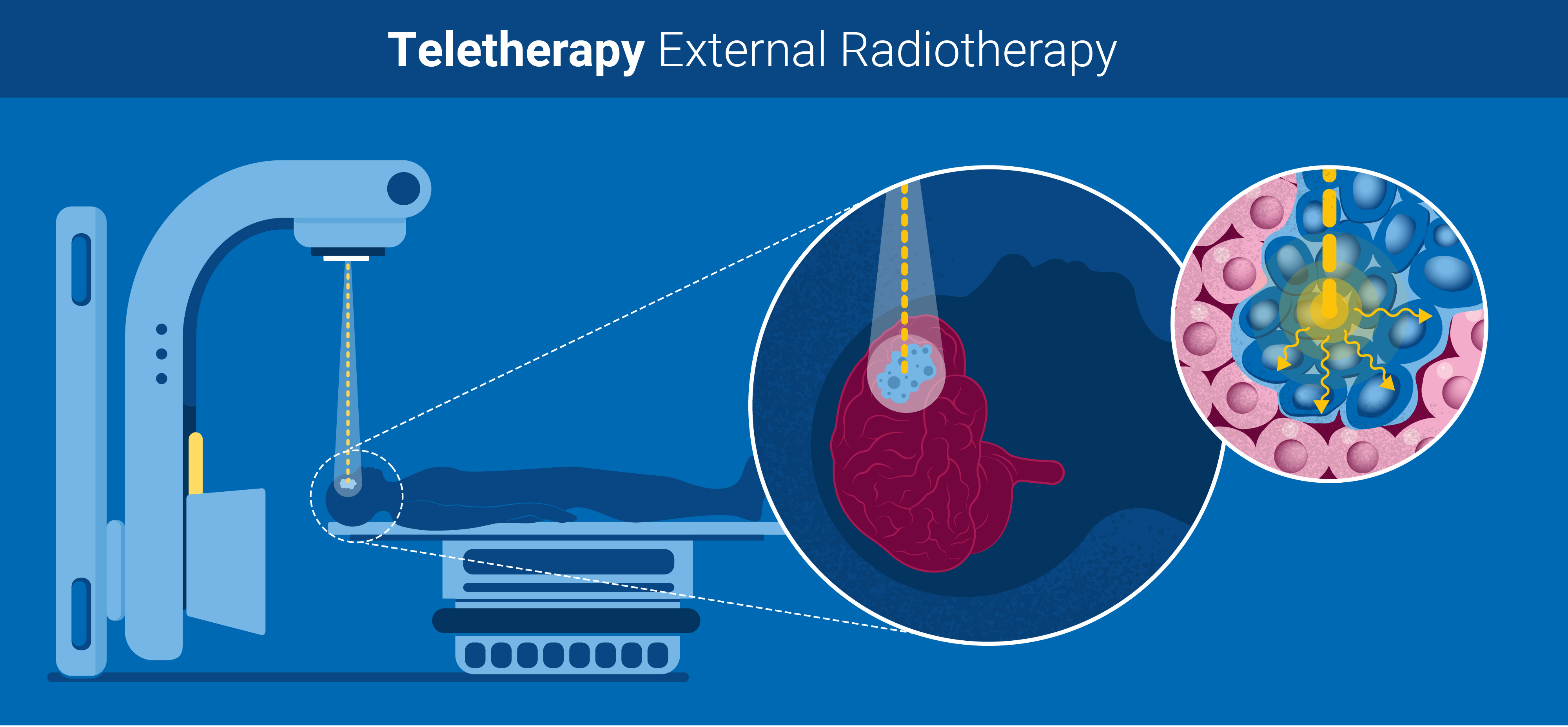
External radiotherapy is used to treat many types of tumours, including in the head, neck, breast, lung or colon. (Graphic: A. Vargas/IAEA)
Brachytherapy
With brachytherapy, a small encapsulated radioactive source is placed inside the body, enabling a high dose of radiation to be delivered directly to the tumour with only minimal impact on the surrounding tissues.
The source can be placed either temporarily or permanently. For temporary application, a capsule containing caesium, iridium or cobalt sources is inserted through a needle or a special applicator. Depending on the dose delivered by the source, the capsule can remain in the body for several minutes to several days. For permanent application, an implant – one example of which is iodine-125 and is usually about the size of a rice grain – is inserted into the body and targets the tumour with radiation, before losing its radioactivity over time.
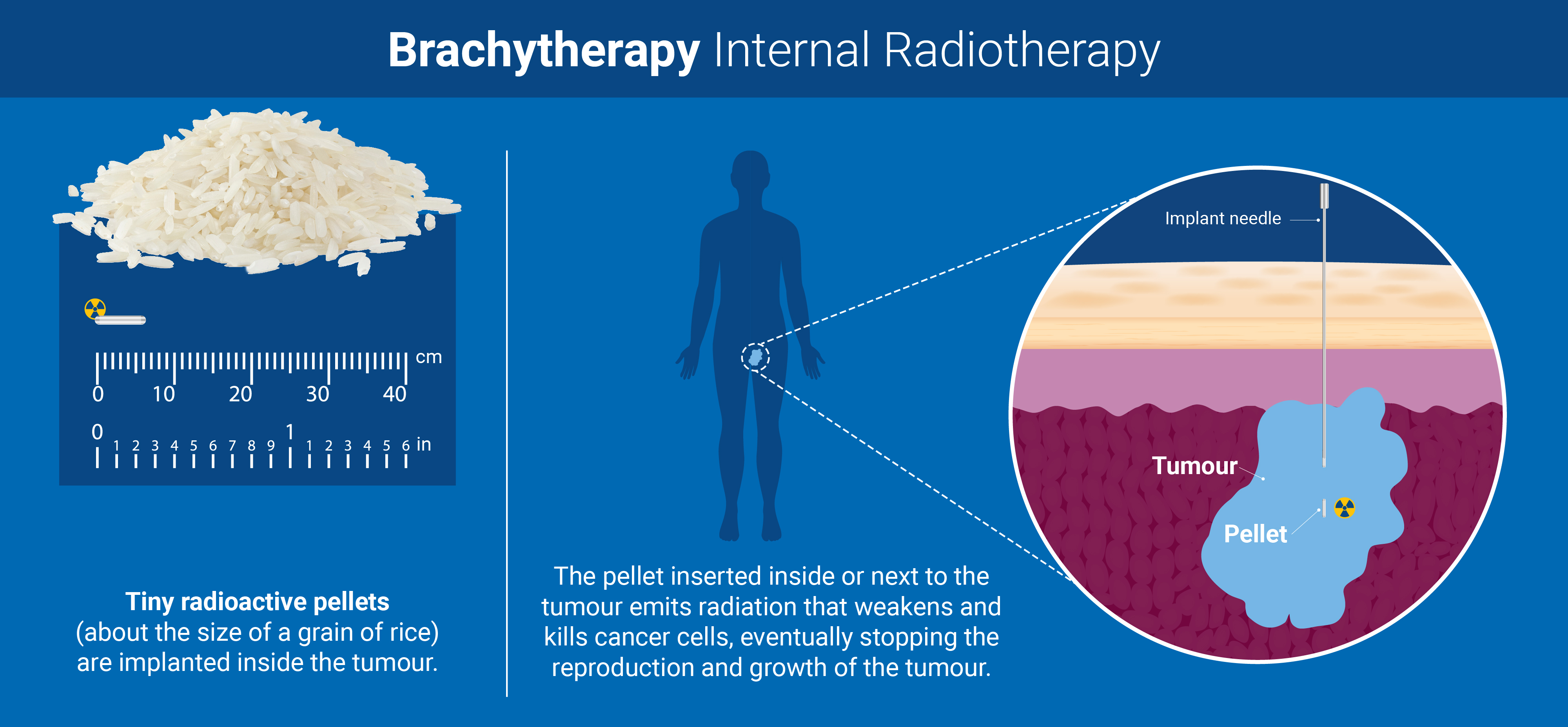
Brachytherapy is often used to treat prostate, breast, skin and some head and neck cancers. (Graphic: A. Vargas/IAEA)
How effective is radiotherapy?
Radiotherapy is a highly effective and well-established treatment that millions of patients undergo every year for brain, breast, head and neck, cervical, prostate, skin and other cancers. The effects of the therapy can be seen over time, rather than immediately, and it can take days, weeks or months after the end of the treatment to see the impact of the radiotherapy on the tumour.
Some of the latest advances in radiotherapy, including 3-D conformal radiotherapy, intensity-modulated radiotherapy and image-guided radiotherapy, help define the target area with high accuracy and effectively deliver precise doses of radiation, causing only minimal damage to healthy cells, tissues and organs.
What are the side effects of radiation therapy?
Side effects depend on the amount of radiation used in radiotherapy and the part of the body that has been irradiated. Patients may experience short- and long-term side effects or no side effects at all.
Is radiotherapy safe?
Teletherapy, conducted with specially designed equipment by a team of highly qualified healthcare professionals, is safe. While patients may experience side effects, others, including doctors or family members near the patient during treatment, are not at any risk of radiation.
Teletherapy does not make patients radioactive. The hazards associated with brachytherapy are also minimal. When the radioactive source is put inside temporarily, the patient remains in the hospital, under special conditions to prevent the staff and public from being exposed to radiation. Once the source has been removed, there is no residual radiation in place.
A permanent implant is placed in such a way that the radiation is absorbed by the tumour. To make sure that the radiation levels are sufficiently low, doctors carry out a special check before they release the patient from the hospital.
What is the role of medical imaging in radiotherapy?
Medical imaging plays a crucial role in cancer patient management and is requisite for the planning, delivery and evaluation of radiotherapy treatment. The integration of advanced imaging techniques in radiotherapy has revolutionised cancer care and improved patient outcomes. In this context, the role of medical imaging includes:
Evaluation of disease location and spread
Determining whether the cancer is at an early stage or has spread to other parts of the body is done through medical imaging. Image-guided procedures such as biopsies are minimally invasive and are necessary for accurate tissue diagnosis.
Medical imaging modalities, such as computed tomography (CT), ultrasound, magnetic resonance imaging (MRI) and positron emission tomography (PET), are essential for accurate cancer diagnosis and staging. These techniques help identify the location, size and extent of the tumour, as well as its relationship to adjacent structures and the presence of metastases.
Treatment planning
Imaging is used for treatment planning: from medication and radiotherapy to surgery or, in certain cases, palliation. During radiotherapy planning, medical imaging generates three-dimensional images of the tumour, allowing for better radiation therapy targeting of the tumour while minimising damage to healthy tissues.
Image-Guided Radiotherapy (IGRT) incorporates real-time medical imaging into the radiotherapy process to ensure accurate and consistent delivery of radiation doses.

Detailed medical images enable health professionals to distinguish between tumours, healthy tissues and organs to ensure cancer cells are correctly targeted. (Photo: Auna Oncosalud)
What is the role of the IAEA?
- In 2022, the IAEA launched the Rays of Hope initiative to support the establishment and expansion of radiotherapy and medical imaging services for cancer patients. Where most needed, it aims at building capacity for radiation medicine and supporting the provision of training, guidance, technology and quality control to countries that currently have little or no access to radiation therapy. In addition, the Rays of Hope initiative supports the development of Anchor Centres, which are regional centres with the aim of enhancing education, research, training, quality assurance and infrastructure in the region.
- Through its Programme of Action for Cancer Therapy (PACT) and in cooperation with the WHO and other global partners, the IAEA supports countries in enhancing their national cancer care services, facilitating the transfer of scientific knowledge, organizing educational and training activities and providing cutting-edge equipment. The assistance provided by the IAEA has helped many countries to set up and strengthen radiation medicine capabilities, including radiotherapy, radiology and nuclear medicine.
- Since 2004, the IAEA has carried out imPACT Reviews — a unique assessment tool which supports countries in improving comprehensive cancer control. imPACT Reviews assess a country’s cancer care capacities and needs to determine priority interventions necessary for effectively responding to its cancer burden.
- The IAEA helps countries with the safe and effective use of radiation medicine, issuing internationally harmonized guidelines and best practice recommendations on radiation dosimetry. It also assists countries in establishing appropriate occupational radiation norms by providing guidance through its Safety Standards.
- The IAEA has established the Human Health Programme to support Member States in using nuclear techniques to prevent, diagnose and treat cancer. The Programme provides technical expertise in radiation oncology and promotes and coordinates research in clinical radiation oncology and applied radiation biology.
- The IAEA maintains a dosimetry laboratory, which plays a key role in establishing and disseminating best practices in the safe and effective use of radiation for the diagnosis and treatment of cancer. The laboratory offers important quality assurance services related to medical physics and dosimetry, including the calibration of reference standards used for dosimetry measurements and dosimetry auditing services.
- The IAEA hosts the Radiation Protection of Patients (RPOP) platform – the leading resource for health professionals, patients and the public on the safe and effective use of radiation in medicine.
- The IAEA maintains a database, the DIrectory of RAdiotherapy Centres (DIRAC). It is the most comprehensive database on radiotherapy resources, including information on radiotherapy centres, teletherapy machines, brachytherapy units, treatment planning systems, computed tomography systems and simulators.

